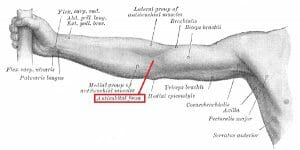Antecubital Fossa Definition
The antecubital fossa, or simply elbow pit, is the small triangular depression in the arm which is formed by the connection of the humerus with the radius and ulna of the forearm. A fossa, in anatomical terms, is from the Latin word meaning small ditch or groove. The numerous muscles and tendons that surround the muscles, as well as the synovial joint formed between the bones of the arm create the antecubital fossa.
Specifically, the antecubital fossa exists in the triangular region created by end of the humerus and two muscles that create a triangle as they attach from the humerus to the wrist. These muscles are the brachioradialis and the pronator teres muscles. The brachioradialis is highlighted in the following image. The antecubital fossa is bounded on the top by the skin and several veins and nerves, while it is bounded on the bottom by more muscles.
The antecubital fossa houses several important structures. The radial nerve passes on the same side of the arm as the radius. The radial nerve supplies many of the muscles of the arm. The median nerve also passes through the antecubital fossa, and continues on to innervate much of the hand. Part of the structure that forms the antecubital fossa is the biceps brachii tendon, which connects the biceps to bone. Lastly, the brachial artery supplies blood to much of the arm, and often divides in the antecubital fossa to become the radial and ulnar arteries. The antecubital fossa can be approximated from these structures in the following image.
Related Biology Terms
- Brachial Artery – The main blood supply vessel in the arm, supplying both the upper arm directly and the forearm and hand through smaller divisions.
- Radial Nerve – A nerve which bounds the edge of the elbow pit, and supplies many of the muscles which operate the arm.
- Median Nerve – The nerve that supplies the hand, and runs directly through the antecubital fossa.
- Humerus – The sole bone of the upper arm, which connects at the elbow to the radius and ulna.
Quiz
1. When you go to the doctor’s office, the doctor may take your blood pressure by placing a stethoscope over your antecubital fossa, and pressurizing a cuff around your upper arm. Which of these structures is the doctor listening to with the stethoscope?
A. Radial Nerve
B. Brachial Artery
C. Cephalic Vein
Antecubital Fossa



No comments:
Post a Comment